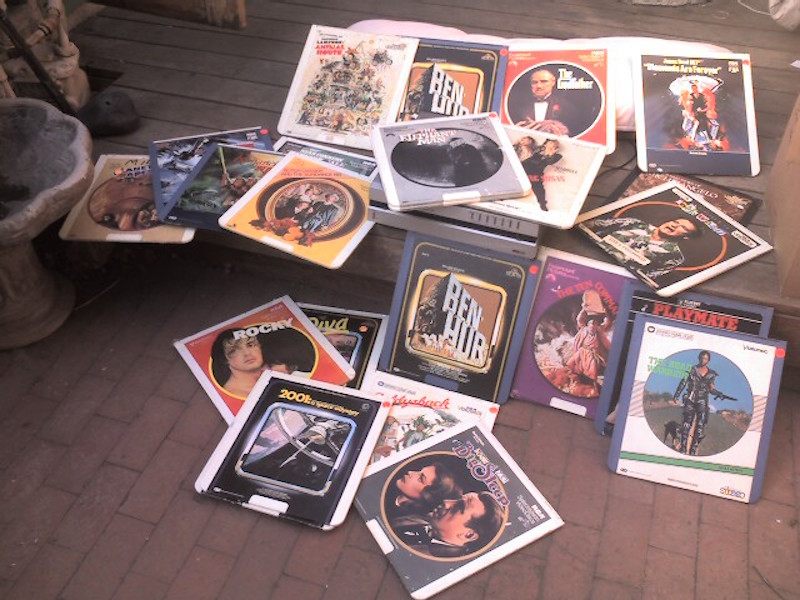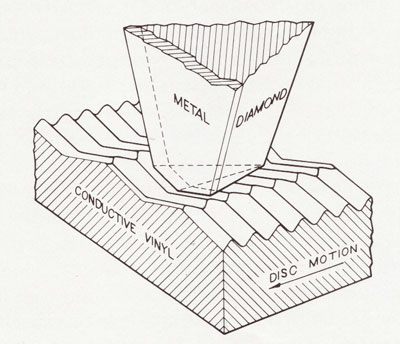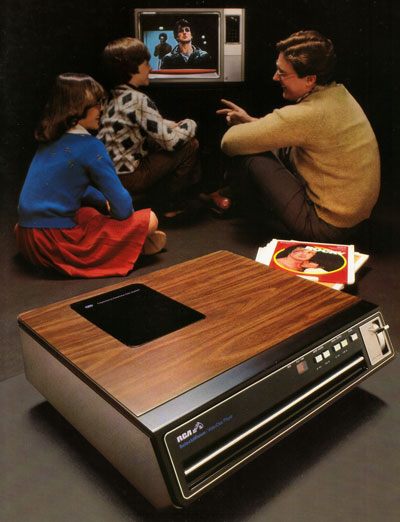The Doomed Effort to Make Videos Go Vinyl

Movies on vinyl: a thing that actually happened. (Photo: Justin Hall on Flickr)
In an alternate universe, movie buffs have Citizen Kane on vinyl. In that alternate universe, unlike in our own, Capacitance Electronic Discs (CEDs) survived instead of being consigned to the same media-format graveyard as Betamax and HD DVD.
Few people even remember that such a medium as vinyl movies existed, but for a brief, doomed period in the early 1980s, home video was available on CEDs. While CED players were not released to consumers until 1981, the development of the system dates back to the 1960s. The idea was that they could encode sound and video information to a vinyl disc if they could only get the grooves small enough.
According to Tom Howe, CED expert and collector, the idea to put moving pictures on a vinyl disc was actually first floated in the 1950s, although work on the unusual system didn’t begin until 1964. The bulk of the early work was done by a pair of RCA employees, Eugene Kaiser and Jon Clemens. Clemens, who had just graduated from MIT with a degree in Electrical Engineering, coming to RCA immediately after school, dug into the project.
Clemens and the team at RCA worked full-time on the project through the end of the 1960s and into the early 1970s, but progress was slow due to the limitations of the available research and the limited resources provided to the It wasn’t until 1970 that the lab was finally able to create a disc that held black-and-white still images. Undaunted by the laborious process, the small team pressed on. By 1971, they had recorded a color image onto their increasingly densely grooved discs. Finally, in 1972, Clemens and his team managed to record 10 full minutes of color video onto one of their discs. The first ever CED had been created, holding a small portion of the Get Smart episode “A Tale of Two Tails” on one side, and an audio recording of various congratulations to the engineers on the other. The visual side of VideoDisc #234, as it was officially known (it was nicknamed “Lum Fong” after a character from the Get Smart episode) contained 4,000 grooves per inch that would be read by a delicate sapphire stylus which was known to break after just a few plays.

How the CEDs work. (Image courtesy of CED Magic)
By 1973, RCA had produced a prototype videodisc player—named “February” after the month in which it went into limited production—that could read their new 10-minute discs and had the ability to move around to different parts of the clip. Ten minutes of video recorded onto the grooves of a vinyl record was an impressive achievement at the time, but it was a far cry from a salable movie playback machine. Work on the project continued, and in 1975 a prototype of a consumer version of the videodisc player was shown to tech professionals , garnering more research resources within RCA. Early laser-read playback technologies that would lead to CDs and Laserdisc were already being developed, but RCA touted the videodisc as a much simpler machine.
Up until this point, CEDs had been made using a layered disc that contained a thin layer of metal coating a vinyl disc, and covered in a lubricant to smooth out the stylus’ ride along the tiny grooves. The stylus, which was so small and fine that it eventually had to be made from slivers of diamond, had a bit of metal that would create a circuit with the metal in the disc, and the visual and audio information would be formed by the wavering capacitance caused by the microscopic grooves. In 1977, when RCA had initially hoped to release the technology, the company moved to a much simpler material made of PVC impregnated with conductive carbon, making the disc itself able to complete the circuit. While this may have been a more elegant solution to the layered discs, it could still only hold about 30 minutes of video at that point.

(Photo: Athnex on Wikipedia)
VHS video players also came out that same year, with Laserdisc following on its heels just a year later in 1978. CEDs were still in the planning phase, but RCA was not about to give up on a project that had been more than 10 years in the making.
Another big problem with CEDs was that as the grooves got tinier and finer, the discs became incredibly delicate. They were easily scratched, and any specks of dust that got into the grooves could cause the stylus to skip and stick. CEDs were originally going to be released like regular vinyl records in paper sleeves, but they proved much too delicate. Thus they were encased in thin plastic caddies so that the discs themselves would be protected. The resulting movies looked not unlike wide, thin eight-track cassettes.

Photo: Windell Oskay on Flickr
According to Howe, in late 1978, an article in Fortune Magazine came out, calling out then RCA chairman Edgar Griffiths, as being afraid of taking risks in his running of RCA. In response, Griffiths announced that home CED players would hit the market within two years. The CED technology became a prime focus for the company. “RCA called it their Manhattan Project,” says Howe. The team finally got the play time on each side of the disc up to one hour, and production began on a commercial player, gearing up for a nationwide roll-out.
Finally, after 17 years in development, flying in the face of evolving trends in home video technology, the first CED machine, the RCA SFT100W VideoDisc player, branded as SelectaVision, was released in March of 1981. Alongside the release of the machine were an initial 50 titles, the very first of which was the cartoon Race For Your Life, Charlie Brown.
VHS, which offered a longer run time in a smaller package, was already well on its way to being the standard video technology in most homes, and when the ungainly, labor intensive (the movie discs had to be manually taken out and turned over halfway through) CED system was released, it was met with a resounding “Huh?” by consumers. Howe says that the video quality was as good as VHS at the time, if not better, but the CED still seemed like a strangely archaic alternative to video cassettes and Laserdisc. In addition, the discs would deteriorate fairly rapidly with consecutive plays. RCA said you could get around 500 spins out of one disc, but the quality fell with each play.

(Photo: Lil_Zebra on Flickr)
RCA ended up selling only around 100,000 players in the first year—half of what the company had ambitiously projected—but they didn’t give up the ghost. CED players continued to be sold over the next few years, even though sales of the machine continued to be dire. In addition to RCA, Toshiba and Hitachi hedged their bets and tried selling CED players as well, but they did no better. The number of titles also continued to grow in the face of the public’s disinterest. Big box office movies of the time like Star Wars, Ghostbusters, and Jaws all made it to CED, but not even these familiar titles could get people into vinyl video.
In 1984, RCA finally admitted defeat. Fewer than 500,000 CED machines had been sold in total, a figure well short of the company’s prediction that half of American homes would have one within 10 years. In April, RCA officially announced the discontinuation of its CED players, soothing the few people who had invested in a machine with the assurance that it would continue to release discs for three more years. They only did so for two. Howe says that only around 45 different models of the CED player were ever released—he has them all—but a surprisingly high 1,700 different titles had made it to market before the platform collapsed.

CEDs hit the market in 1981. (Photo courtesy of CED Magic)
As a somewhat melancholy endnote, the final vinyl video discs to be released were The Jewel of the Nile and a commemorative short film called Memories of VideoDisc, which was given to a number of RCA employees who had been involved with the CED’s development. With that, the brief, doomed life of CEDs came to an end.
Today CEDs are all but forgotten save for the minds of a few collectors like Howe. The players themselves are relatively rare, but the discs can still be found all over eBay, or sitting on thrift store shelves. The whole fool’s errand that the CED became is an odd but memorable footnote in the ever-expanding history of home entertainment.







Follow us on Twitter to get the latest on the world's hidden wonders.
Like us on Facebook to get the latest on the world's hidden wonders.
Follow us on Twitter Like us on Facebook